IBM, Amazon foreshadow a bevy of connecting clouds; Is Microsoft surrounded?

If there were any lingering doubts about whether Amazon Web Services were enterprise ready they dissolved this week once IBM became a partner. And now that Amazon and IBM have teamed up a picture of multiple computing clouds is emerging.
Amazon Web Services teamed up with IBM to provide pay-as-you-go access to Big Blue's database servers, Lotus and Websphere middleware running on Novell SUSE Linux. Those applications will run on Amazon's EC2.
While the details have been covered what's notable is the vision. IBM's cloud will connect to Amazon's and licenses will also carry over. To the enterprise IBM's endorsement makes Amazon an official member of the corporate cloud club. Sure, partners like Capgemini, Salesforce.com, Sun's MySQL and OpenSolaris, Oracle and Red Hat all gave Amazon enterprise clout, but IBM seals the deal.
Also see:Migrating to Amazon Web Services: The blueprint
IBM's motives are clear: It wants to sell you everything that translates into cloud computing: Hardware, software, middleware and services. The key part will be the software. IBM also foreshadowed that this week with its cloud announcement with Juniper Networks.

IBM sees public clouds, private cloud and corporate networks all comingled (all BTL and ZDNet cloud computing posts). Toss in efforts by smaller players like 3Tera and you can see these clouds connecting in the years to come.
Is Microsoft surrounded?
The push toward interconnecting clouds could become a big threat to Microsoft. Speaking about the Amazon-IBM pact, Dana Gardner noted that Big Blue and Amazon are "the best of bedfellows" and added:Together they form the irresistible gravitational black hole from which Microsoft can not escape. And Google is building another black hole right next door. And so is Salesforce.com.
Can Microsoft change universal physics? Not likely.
What this deal means is that Microsoft will need to adopt the cloud model all the more quickly and comprehensively — across its software lines, not just a few. It’s going to be Live Stack, not just Live Mesh. It’s going to be buy once, run any which way.
Meanwhile, Dana argues that the cloud pricing models are going to squeeze Microsoft's margins.
All of those arguments make a lot of sense and clearly mean that Microsoft's Azure cloud effort is the software giant's most important. But the assumption is that Azure won't connect to the other cloud computing platforms being created. Rest assured that Azure will connect to the rest of the clouds whether they are Amazon's, IBM's or someone else's. Microsoft will have to play ball and its sheer girth will mean it will also have a say in standards.
Also see: Microsoft’s Azure cloud platform: A guide for the perplexed
Microsoft, Amazon take different paths to cloud caching
Microsoft datacenter architect defects to Amazon
The end game: It's a cloud community
As noted previously, the cloud computing game won't be zero sum. SAP, HP, Oracle, Microsoft and others are going to be big cloud computing players. And there will be open connections to tie these efforts together.This handy map shows the landscape as it stands today:
In the future, there will be a bunch of other players with a lot of interconnections represented.